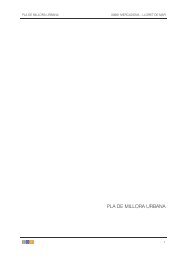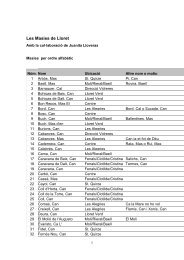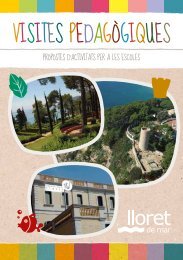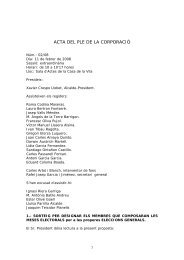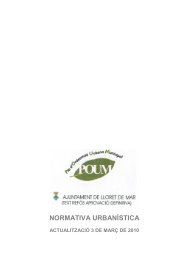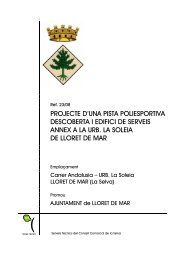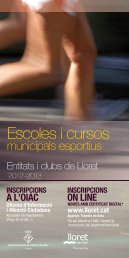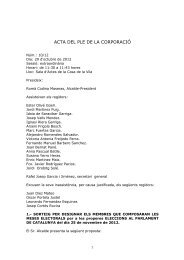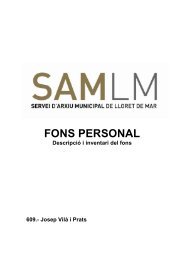Agenda XXI LLORET DE MAR (GB) - Ajuntament de Lloret de Mar
Agenda XXI LLORET DE MAR (GB) - Ajuntament de Lloret de Mar
Agenda XXI LLORET DE MAR (GB) - Ajuntament de Lloret de Mar
Create successful ePaper yourself
Turn your PDF publications into a flip-book with our unique Google optimized e-Paper software.
2.2.2 A View of the Territory<br />
Anthropic activity affecting the territory has intensified over the past <strong>de</strong>ca<strong>de</strong>s, and a series of<br />
changes have materialised. Changes of an economic, technological, political, cultural, and<br />
social origin. The world is ever-changing, but never before have these changes taken place<br />
with such intensity and speed, nor in such an autonomous fashion, so free from premeditated<br />
intentions, bursting through frameworks and parameters which appeared to be stable, and<br />
bursting through conventional planning tools. The quantity and diversity of initiatives and their<br />
vertiginous pace make <strong>de</strong>cision-making processes more complex and dispersed.<br />
The transformation of the territory has been and is virtually always contradictory. On one hand<br />
the creation of wealth, the physical mobility of persons and the permeability between social<br />
strata represent benefits (or they are simply necessary for the <strong>de</strong>velopment of civilisation), and<br />
on the other, it presents negative aspects resulting from the improper use or abuse of certain<br />
anthropic actions against the milieu. The effect of such actions is not limited only to the natural<br />
milieu, since the mistake is often ma<strong>de</strong> of i<strong>de</strong>ntifying the territory from an exclusively physical<br />
perspective, leaving the human perspective – i.e., political, cultural and ethical relationships<br />
generated in this space - in the background, or even forgetting it altogether.<br />
It is in this aspect – the human perspective – where the connection between the territory and<br />
any act is observed, since it is in this space where the human theories and practices are put in<br />
motion. Everything takes place in and on the territory, and this is what <strong>de</strong>termines the essence<br />
of a space, because it presents a reality which particularises it, which makes it singular and<br />
unique. Each territory evolves in a different way, and its complementary sites are not exclu<strong>de</strong>d,<br />
but rather are nee<strong>de</strong>d in or<strong>de</strong>r to be <strong>de</strong>fined – it is necessary to find what others are missing,<br />
which is what in<strong>de</strong>ed gives value to oneself. Diversity enriches, and at the same time it <strong>de</strong>fines<br />
each territorial i<strong>de</strong>ntity.<br />
Territorial I<strong>de</strong>ntity<br />
A territorial i<strong>de</strong>ntity is not created artificially, nor is it improvised. It consists of a series of roots<br />
which have been shaped over time and of contact with various cultures, generating itself<br />
naturally and becoming a part of larger regions and territories. A territorial i<strong>de</strong>ntity is a set of<br />
values, of approaches and of lifestyles, modulated and han<strong>de</strong>d down over the generations,<br />
imbued, beyond doubt, with common traits at the broa<strong>de</strong>st scale; in other words, a territory on<br />
a small scale is unique in its i<strong>de</strong>ntity and, at the same time it belongs, in a series of concentric<br />
circles, to larger territories which are also unique in their i<strong>de</strong>ntities. Within these digressions we<br />
must inclu<strong>de</strong> the consi<strong>de</strong>ration of the term landscape – the "landscape", un<strong>de</strong>rstood as a<br />
human, natural and cultural landscape, becomes or equals the i<strong>de</strong>ntity of the territory, and it<br />
represents it everywhere. Faced with the difficulty posed by consi<strong>de</strong>ring the term landscape in<br />
its broa<strong>de</strong>st sense, we have chosen to inclu<strong>de</strong> a number of consi<strong>de</strong>rations ma<strong>de</strong> in this regard<br />
by the geographer Joan Nogué i Font in the following box.<br />
26



